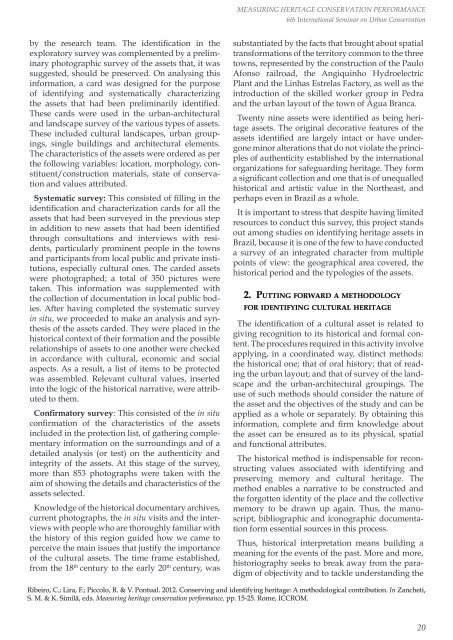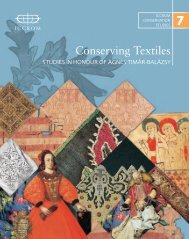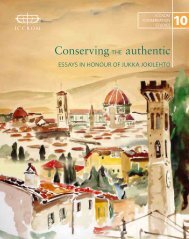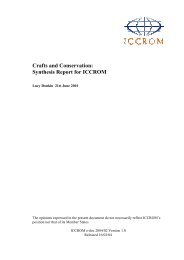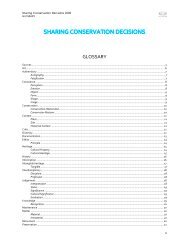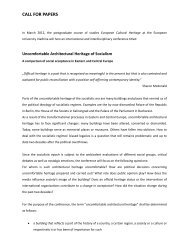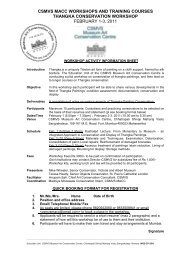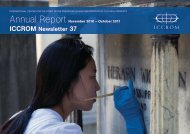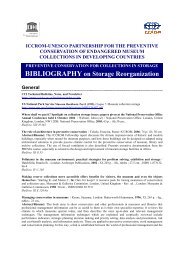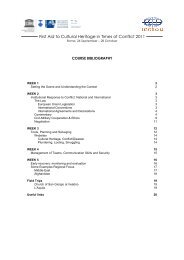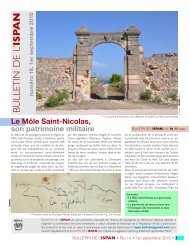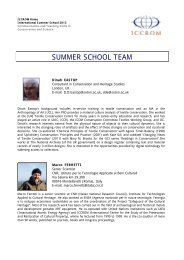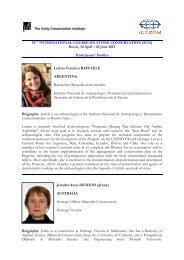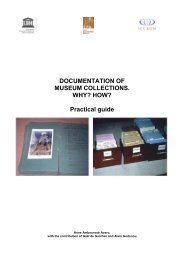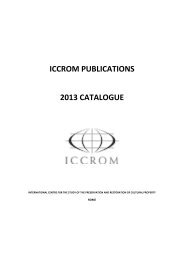part 1 - Iccrom
part 1 - Iccrom
part 1 - Iccrom
You also want an ePaper? Increase the reach of your titles
YUMPU automatically turns print PDFs into web optimized ePapers that Google loves.
MEASURING HERITAGE CONSERVATION PERFORMANCE<br />
6th International Seminar on Urban Conservation<br />
by the research team. The identification in the<br />
exploratory survey was complemented by a preliminary<br />
photographic survey of the assets that, it was<br />
suggested, should be preserved. On analysing this<br />
information, a card was designed for the purpose<br />
of identifying and systematically characterizing<br />
the assets that had been preliminarily identified.<br />
These cards were used in the urban-architectural<br />
and landscape survey of the various types of assets.<br />
These included cultural landscapes, urban groupings,<br />
single buildings and architectural elements.<br />
The characteristics of the assets were ordered as per<br />
the following variables: location, morphology, constituent/construction<br />
materials, state of conservation<br />
and values attributed.<br />
Systematic survey: This consisted of filling in the<br />
identification and characterization cards for all the<br />
assets that had been surveyed in the previous step<br />
in addition to new assets that had been identified<br />
through consultations and interviews with residents,<br />
<strong>part</strong>icularly prominent people in the towns<br />
and <strong>part</strong>icipants from local public and private institutions,<br />
especially cultural ones. The carded assets<br />
were photographed; a total of 350 pictures were<br />
taken. This information was supplemented with<br />
the collection of documentation in local public bodies.<br />
After having completed the systematic survey<br />
in situ, we proceeded to make an analysis and synthesis<br />
of the assets carded. They were placed in the<br />
historical context of their formation and the possible<br />
relationships of assets to one another were checked<br />
in accordance with cultural, economic and social<br />
aspects. As a result, a list of items to be protected<br />
was assembled. Relevant cultural values, inserted<br />
into the logic of the historical narrative, were attributed<br />
to them.<br />
Confirmatory survey: This consisted of the in situ<br />
confirmation of the characteristics of the assets<br />
included in the protection list, of gathering complementary<br />
information on the surroundings and of a<br />
detailed analysis (or test) on the authenticity and<br />
integrity of the assets. At this stage of the survey,<br />
more than 853 photographs were taken with the<br />
aim of showing the details and characteristics of the<br />
assets selected.<br />
Knowledge of the historical documentary archives,<br />
current photographs, the in situ visits and the interviews<br />
with people who are thoroughly familiar with<br />
the history of this region guided how we came to<br />
perceive the main issues that justify the importance<br />
of the cultural assets. The time frame established,<br />
from the 18 th century to the early 20 th century, was<br />
substantiated by the facts that brought about spatial<br />
transformations of the territory common to the three<br />
towns, represented by the construction of the Paulo<br />
Afonso railroad, the Angiquinho Hydroelectric<br />
Plant and the Linhas Estrelas Factory, as well as the<br />
introduction of the skilled worker group in Pedra<br />
and the urban layout of the town of Água Branca.<br />
Twenty nine assets were identified as being heritage<br />
assets. The original decorative features of the<br />
assets identified are largely intact or have undergone<br />
minor alterations that do not violate the principles<br />
of authenticity established by the international<br />
organizations for safeguarding heritage. They form<br />
a significant collection and one that is of unequalled<br />
historical and artistic value in the Northeast, and<br />
perhaps even in Brazil as a whole.<br />
It is important to stress that despite having limited<br />
resources to conduct this survey, this project stands<br />
out among studies on identifying heritage assets in<br />
Brazil, because it is one of the few to have conducted<br />
a survey of an integrated character from multiple<br />
points of view: the geographical area covered, the<br />
historical period and the typologies of the assets.<br />
2. Putting forward a methodology<br />
for identifying cultural heritage<br />
The identification of a cultural asset is related to<br />
giving recognition to its historical and formal content.<br />
The procedures required in this activity involve<br />
applying, in a coordinated way, distinct methods:<br />
the historical one; that of oral history; that of reading<br />
the urban layout; and that of survey of the landscape<br />
and the urban-architectural groupings. The<br />
use of such methods should consider the nature of<br />
the asset and the objectives of the study and can be<br />
applied as a whole or separately. By obtaining this<br />
information, complete and firm knowledge about<br />
the asset can be ensured as to its physical, spatial<br />
and functional attributes.<br />
The historical method is indispensable for reconstructing<br />
values associated with identifying and<br />
preserving memory and cultural heritage. The<br />
method enables a narrative to be constructed and<br />
the forgotten identity of the place and the collective<br />
memory to be drawn up again. Thus, the manuscript,<br />
bibliographic and iconographic documentation<br />
form essential sources in this process.<br />
Thus, historical interpretation means building a<br />
meaning for the events of the past. More and more,<br />
historiography seeks to break away from the paradigm<br />
of objectivity and to tackle understanding the<br />
Ribeiro, C.; Lira, F.; Piccolo, R. & V. Pontual. 2012. Conserving and identifying heritage: A methodological contribution. In Zancheti,<br />
S. M. & K. Similä, eds. Measuring heritage conservation performance, pp. 15-25. Rome, ICCROM.<br />
20


